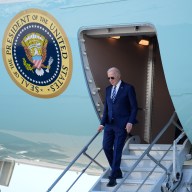BEIJING – Chinese mountaineers made final preparations Wednesday to take the Olympic flame up Mount Everest in a grand but contentious feat that is being accorded an unusual mixture of fanfare and secrecy.
As China marked 100 days before the start of the Olympics, state-run television began the first of what were billed as elaborate and technically difficult live broadcasts from Everest’s base camp for the journey up the world’s tallest peak.
Mountaineers were completing the setup of a staging point at 8,300 metres for the final assault on the 8,850-metre summit, Chinese Central Television reported.
There was no word on the flame’s whereabouts or those of the 31-member team that would go to the summit. Nor was there any news on which members would ascend to the peak or when.
The website of Beijing Daily likened the lack of information to a “mysterious veil that has surrounded base camp.”
Some media reports had speculated that the climb could come as early as Wednesday – when the countdown clock in Beijing marked 100 days to the Aug. 8-24 games – or Thursday – the May Day holiday.
A brewing storm made a climb in the next three days unlikely, the Xinhua news agency said late Wednesday, citing Yang Xingguo, the expedition’s weather expert at base camp.
To commemorate the 100-day mark, Beijing held a mini-marathon outside the nearly completed National Stadium, known as the Bird’s Nest, and a song gala where actor Jackie Chan joined other celebrities to sing “Beijing Welcomes You,” which was written for the event.
Senior Communist party leader Jia Qinglin urged all Chinese “to pool our patriotic passion to accumulate a mighty force that could overcome all difficulties to in a bid to hold a successful Olympics.”
Meanwhile, the Chinese and foreign reporters at Everest base camp wait.
Still billed as a spectacular event, the Everest climb is being given mixed treatment. With the torch relay dogged by protests and Beijing’s oft-criticized rule in Tibet drawing heated scrutiny after demonstrations this spring, organizers have placed a premium on security.
The Everest flame was specially designed to burn in frigid, windy, oxygen-thin Himalayan air. It is a sister flame to the one that made its way around the world and reached Hong Kong on Wednesday, returning to Chinese territory after a contentious month abroad.
While it may face some protests when it is run through Hong Kong and neighbouring Macau on Friday and Saturday, the torch then moves to less-contested territory for a three-month journey across mainland China.
In a sign of the Hong Kong government’s determination for a smooth relay, border control officials turned away at least seven people, among them a Danish and two Canadian activists, apparently suspecting they were coming to Hong Kong to stage protests. The Canadians were Kate Woznow and Tsering Lama, organizers of Students for a Free Tibet.
Woznow, formerly of Vancouver, said pro-Tibet groups will take further action coinciding with the coming Everest event.
They are “planning a global vigil, a global prayer, on the moment when the Chinese government does try to summit Mount Everest with the Olympic torch, because it is sort of a sacred mountain for Tibetans,” Woznow said after returning to New York, where she now lives.
“It is also a clear sign that the Chinese government is trying to use the Olympic torch to stake a political claim over Tibet. So it will be sort of a global day of action when that happens.”
Chinese officials did not publicize the flame’s travel to the Everest base camp. Beijing has also exercised its diplomatic clout, persuading Nepal to bar climbers from border-straddling Everest’s southern face to keep potential protesters from reaching the peak and spoiling the torch’s moment.
But the secrecy has also dented plans by organizers and CCTV, which spent heavily on special broadcast facilities.
“It’s a challenging mountain, not because of technical problems. It’s easy technically. But because of the height, it’s difficult and dangerous,” said Pierre Maina, a Danish surgeon and mountaineer who is preparing to scale Everest from Tibet next year.
Oxygen bottles are a must above 7,848 metres, the Tibet Mountaineering Training School said. Everest’s northern face is said to be subject to harsher, windier weather than the Nepal side, with usually just two chances to make the summit in May, the choice season for climbing.
The head of the China Mountaineering Association, Wang Yongfeng, has said he nearly died in a 1993 Everest expedition in part because he used up his oxygen bottle near the summit and emergency supplies were at camps below. “Regardless of the weather, we must get the sacred flame of the Olympics to shine over Mount Qomolangma,” state media has quoted Wang as saying, using the Chinese name for Everest.
Maina, the Danish climber, was at the base camp of nearby Cho Oyu in September 2006 and saw Chinese security shoot at Tibetans fleeing over the Nangpa pass to try to reach Nepal. A Buddhist nun was killed, and the experience coloured Maina’s views about the Olympic flame’s Everest trek.
“What I experienced in Tibet makes feel bad about what they are doing with the Olympic Games,” he said by phone from Denmark.
State media and Olympic officials have said that the Everest climb would symbolize universal Olympic ideals and have largely omitted talk about Chinese dominance. A newspaper in Hubei province said the ascent would “create a peak for Olympic history and give expression to the acme of the Olympic spirit.”
















